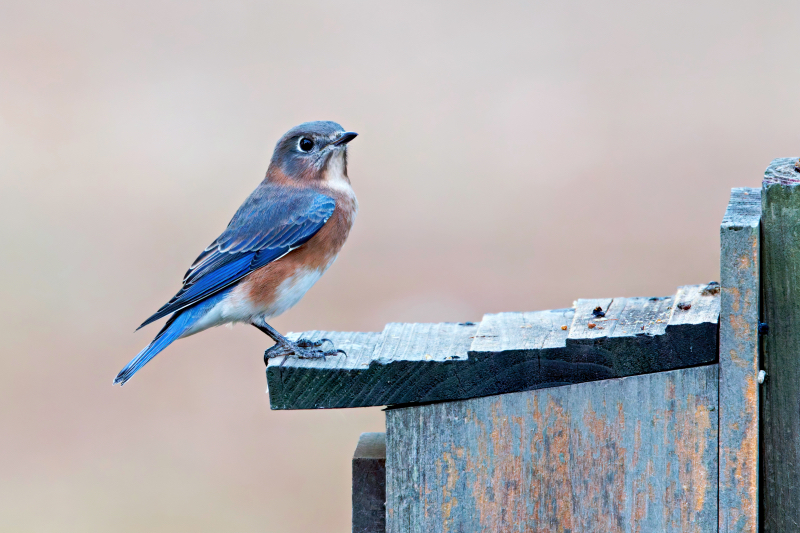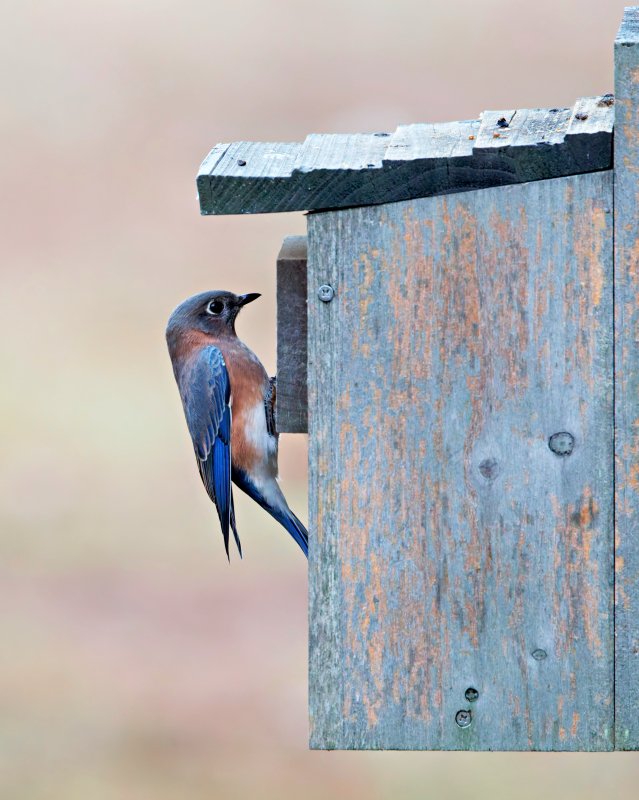Even though it’s early fall, I’ve noticed a pair of Eastern Bluebirds showing some interest in the birdhouse I set up in my yard. Over the past few days, this pair has been regularly checking out the birdhouse, confirming the value of keeping birdhouses up year-round. This behavior aligns with what I discussed in my previous blog post, “Why You Should Leave Birdhouses Up Year-round.” The recent activity serves as a great reminder that birdhouses can benefit birds even beyond the traditional breeding season.

Early Fall Birdhouse Exploration
What’s fascinating about this pair of bluebirds is how they interact with the birdhouse. The female has been going inside the birdhouse and staying for a few seconds each time. While she’s inside, the male flies up to the entrance and peers in, as if he’s inspecting the space or keeping an eye on her. This behavior suggests that the bluebirds are already thinking ahead, perhaps considering the birdhouse as a roosting site for the cooler months ahead.

Technical Details of the Shot
To document the bluebird activity, I used the following camera setup:
- Date: 10/20/24
- Time: 7:42:39 AM
- Camera: Canon EOS R5 Mark 2
- Lens: Canon RF 100-500mm
- Focal Length: 500mm
- ISO: 6400
- Aperture: f/8
- Shutter Speed: 1/200 sec
- Exposure Compensation: +0.7
These settings helped me capture clear images of the bluebirds despite the early morning lighting conditions. The high ISO of 6400 was necessary to maintain a fast enough shutter speed to avoid motion blur, while the +0.7 exposure compensation brightened the image to bring out the birds’ details.
Why Leave Birdhouses Up Year-round?
The activity of these bluebirds in early fall reinforces the point I made in my blog post, “Why You Should Leave Birdhouses Up Year-round.” Birdhouses aren’t just for spring nesting; they can provide valuable shelter during fall and winter. Many birds, including Eastern Bluebirds, will use birdhouses as a place to roost overnight, especially when temperatures drop. These shelters can help birds conserve energy and stay warm during chilly nights, which is crucial for their survival.
Preparing Birdhouses for Winter
It’s important to ensure that birdhouses are clean and in good condition as we head into winter. I wrote a detailed guide on this in my previous blog post, “Preparing Birdhouses for Eastern Bluebirds in Winter.” Preparing the birdhouses now can encourage bluebirds and other cavity-nesting birds to use them as roosting sites. This can involve removing old nests, checking for damage, and making any necessary repairs. Adding some dry grass or wood shavings inside can also help insulate the birdhouse and make it more inviting.
Observations and the Importance of Birdhouses
Watching the interactions between this pair of Eastern Bluebirds has been a treat. Their early interest in the birdhouse indicates that they are already scouting for suitable shelter, which might serve them well as temperatures continue to cool. It’s moments like these that remind us of the importance of keeping birdhouses up all year and maintaining them as safe, inviting spaces for birds.
For those who have birdhouses in their yards, take a few minutes to observe if any birds are showing interest. Early fall can be an ideal time for birds to start using birdhouses as roosting spots, and a little preparation can go a long way in supporting these beautiful creatures throughout the year.
Stay tuned for more updates on the bluebirds and other wildlife activity in my yard!

That is interesting regarding leaving birdhouses up over the winter. Last night, I was just thinking of that. We were sitting on our deck as the sun was setting and beginning to get dark. I noticed a sparrow that flew up, saw us, and flew away. It came back soon and entered a small hanging wicker birdhouse we have hanging from the roof overhang. That got me to thinking about our other birdhouses and if they were also being used for shelter at night or perhaps in the coming winter here in Northern Illinois. And thanks for the photo details.